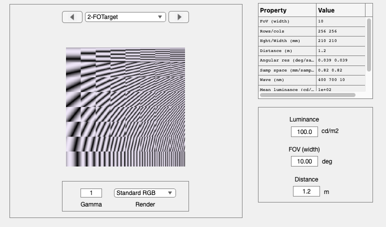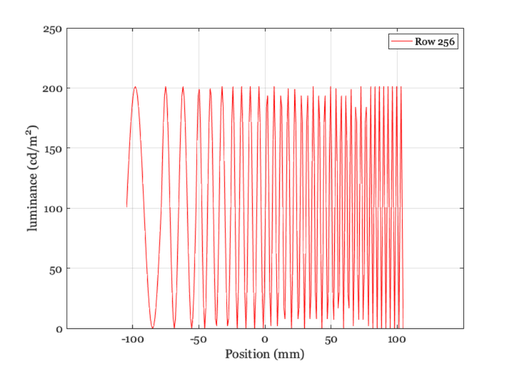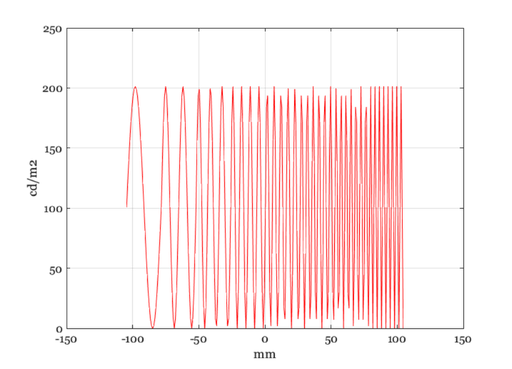Illustrate how to create and interact with scenes
Simulations typically begin with a scene object. This script illustrates how to create a scene of the Macbeth ColorChecker illuminated with a D65 light. It then illustrates different ways to programmatically interact with the scene object.
We illustrate * how to display a downsampled (3 color channels) representation of the scene in the Display window. * Read properties of the scene using sceneGet . * Create a frequency-orientation scene target * Extract and plot scene luminance (cd/m^2) across a row of that target.
See also: sceneCreate, s_sceneFromMultispectral, s_sceneFromRGB
Copyright ImagEval Consultants, LLC, 2003.
Contents
ieInit;
% We validate some of the ISET calculations by the numerical tolerance
tolerance = 1e-5;
sceneCreate
% To create a simple spectral scene of a Macbeth Chart under a % D65 illuminant, we use % sceneMacbethD65 = sceneCreate('macbethd65');
sceneWindow
% To place the scene data in the window, add the scene object to % the session and select it. % ieAddObject(sceneMacbethD65); % % Then bring up the scene window. You can interact with the % scene through this window sceneWindow; pause(0.2); %
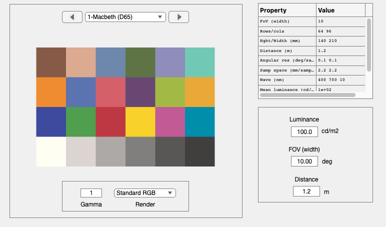
sceneGet
% To manipulate the data in a scene, you can extract variables sceneGet(sceneMacbethD65,'meanLuminance') % Image of the luminance map of the Macbeth luminance = sceneGet(sceneMacbethD65,'luminance'); ieNewGraphWin; imagesc(luminance); axis image; colormap(gray(64)); % To access directly the photons in the image, do this: photons = sceneGet(sceneMacbethD65,'photons'); % This is a small image, but notice that it is row by col by % wavelength size(photons) % The values are big because they are photons emitted per second % per wavelength per steradian per meter from the scene assert( abs(max(photons(:))/ 1.3119e+16 - 1) < tolerance,'Max photon error'); % These are the wavelength sample values in nanometers wave = sceneGet(sceneMacbethD65,'wave'); % Suppose we compute the mean number of photons across the entire % image meanPhotons = mean(photons,1); meanPhotons = mean(meanPhotons,2); meanPhotons = squeeze(meanPhotons); assert(abs(mean(meanPhotons(:)) / 3.7624e+15 - 1) < tolerance,'Mean photon error');
ans =
100.0000
ans =
64 96 31
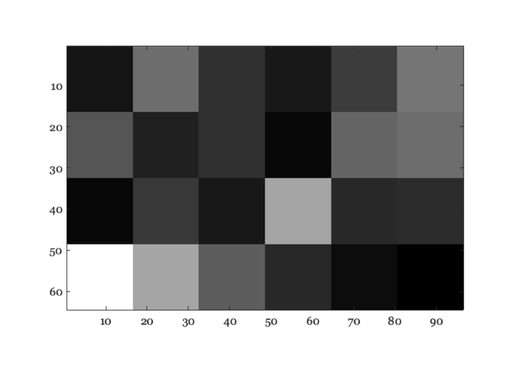
Plot the mean radiance
ieNewGraphWin; plot(wave,meanPhotons); xlabel('Wavelength (nm)'); ylabel('Radiance (q/sec/nm/sr/m^2'); grid on

sceneDescriptions
% To see a general description of the scene, the one printed in % the upper right of the window, we use this txt = sceneDescription(sceneMacbethD65); disp(txt); % Many other quantites can be stored or derived, such as the % horizontal field of view in degrees fprintf('FOV: %f\n',sceneGet(sceneMacbethD65,'fov')) % To change the field of view sceneMacbethD65 = sceneSet(sceneMacbethD65,'fov',20); fprintf('FOV: %f\n',sceneGet(sceneMacbethD65,'fov'))
Row,Col: 64 by 96 Hgt,Wdth (139.98, 209.97) mm Sample: 2.19 mm Deg/samp: 0.10 Wave: 400:10:700 nm DR: 26.04 dB (max 320 cd/m2) FOV: 10.000000 FOV: 20.000000
Different types of scenes
% There are many types of scenes. Here is a simple one that is % useful for demosaicing. For a list, type help sceneCreate sceneTest = sceneCreate('freq orient pattern'); sceneWindow(sceneTest); pause(0.2); % With this one, we might try some simple plots, such as a plot % of the luminance across the bottom row sz = sceneGet(sceneTest,'size'); scenePlot(sceneTest,'luminance hline',sz); % We can do this ourselves by getting the luminance of this % bottom row as follows luminance = sceneGet(sceneTest,'luminance'); data = luminance(sz(1),:); support = sceneSpatialSupport(sceneTest,'mm'); ieNewGraphWin; plot(support.x,data,'-'); xlabel('mm'); ylabel('cd/m2'); grid on rows = round(sceneGet(sceneTest,'rows')/2); assert(rows == 128,'Row test failed') scenePlot(sceneTest,'radiance hline',[1,rows]);
